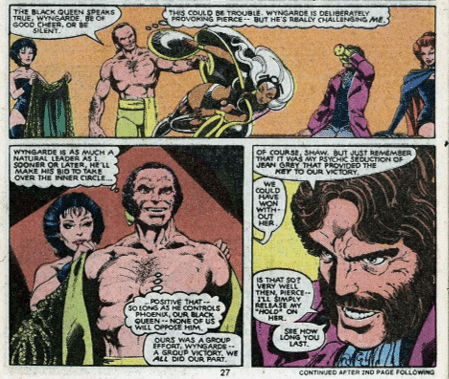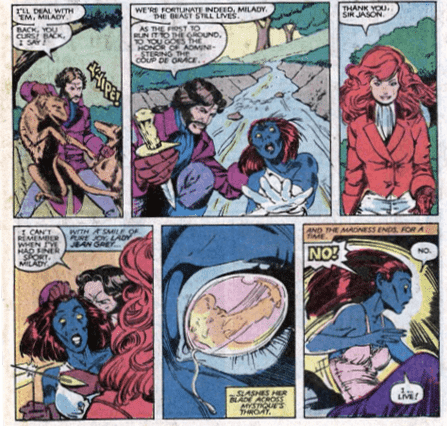A People’s History of the Marvel Universe, Week 14 (The Hellfire Club)
 When Chris Claremont was handed the reins in Uncanny X-Men #94, he took the opportunity to put his stamp on almost every facet of their world – and the mutant metaphor was no exception. Given his xtra-ordinarily long tenure on the X-books, it would be impossible to cover his contributions in one essay, so this will be the first in a series of essays exploring how Claremont mutated the metaphor.
As I mentioned way back in Week 4, it took a while for Claremont to bring in the metaphor, and even then the issue is more of an homage to Uncanny X-Men #57 (which he had helped with as an intern) rather than a fully-fledged creation of his own. His “voice” begins to really sing with “the Phoenix Saga” (#97-108), but as I’ve talked about elsewhere, the Phoenix Saga really sings more as a space opera and personal drama rather than a story about what it means to be a mutant.
However, I will argue that Uncanny X-Men #129 is where Claremont really starts to say something about the mutant metaphor with the introduction of his first new mutant antagonists, the Hellfire Club.
So what is the Hellfire Club and what does it stand for?
Filthy Rich, Emphasis on the Filthy
When Chris Claremont was handed the reins in Uncanny X-Men #94, he took the opportunity to put his stamp on almost every facet of their world – and the mutant metaphor was no exception. Given his xtra-ordinarily long tenure on the X-books, it would be impossible to cover his contributions in one essay, so this will be the first in a series of essays exploring how Claremont mutated the metaphor.
As I mentioned way back in Week 4, it took a while for Claremont to bring in the metaphor, and even then the issue is more of an homage to Uncanny X-Men #57 (which he had helped with as an intern) rather than a fully-fledged creation of his own. His “voice” begins to really sing with “the Phoenix Saga” (#97-108), but as I’ve talked about elsewhere, the Phoenix Saga really sings more as a space opera and personal drama rather than a story about what it means to be a mutant.
However, I will argue that Uncanny X-Men #129 is where Claremont really starts to say something about the mutant metaphor with the introduction of his first new mutant antagonists, the Hellfire Club.
So what is the Hellfire Club and what does it stand for?
Filthy Rich, Emphasis on the Filthy



























[1] Neil isn’t far wrong. For example, in issue #182, we learn that the Hellfire Club has double agents working within SHIELD whom they can order to assassinate U.S military intelligence operatives without any fear of retaliation from the U.S government. [2] Uncanny X-Men #130, p. 8. [3] Uncanny X-Men #129, #151. [4] Although given Sebastian Shaw’s penchant for taking off his shirt and getting punched by well-muscled men, it’s not entirely straight. [5] Since Classic X-Men were reprints with edits, interpolated panels, and new back-up stories written by Chris Claremont about a decade after the originals came out, this moment can’t help but have the air of a correction issued by a creator with a track record of listening to and responding to feminist critics of his work. [6] For those unfamiliar with British politics, this form of hunting – pursuing foxes from horseback with hounds – and the uniform of red coats and black top-hats is associated with a particularly aristocratic tradition in the U.K that become popular in the 18th century and increasingly controversial up to the present. Both out of animal cruelty concerns and because of the quasi-feudal nature of the hunt, where upper-class horseman run literally roughshod across other people’s lands, there have been a number of attempts to ban fox-hunting, eventually leading to the Hunting Act of 2004 under New Labour. Notably, the Tory governments of David Cameron and Teresa May have proposed repealing the ban due to pressure from rural Tory voters, although no legislation has yet been brought forward.


